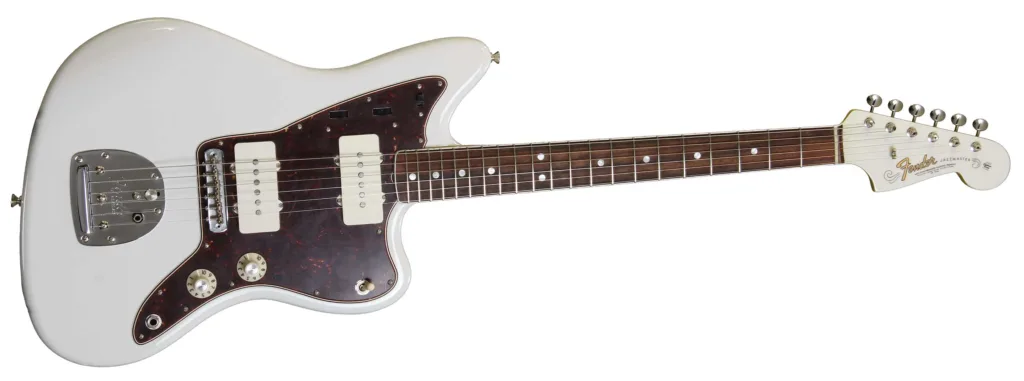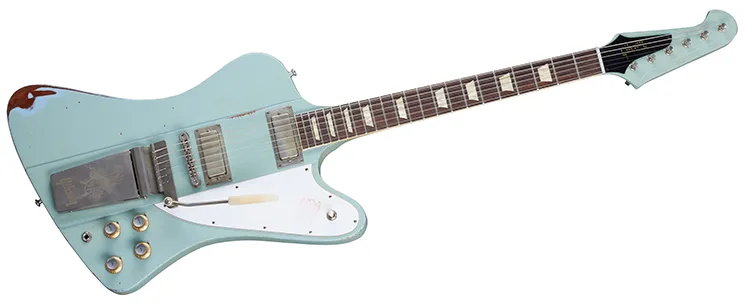Have you ever heard of an offset guitar, but weren’t quite sure what it was? Maybe you’ve seen one used by your favorite rock star and wondered if it’s the right type of guitar for you. Well, you’re in luck! As someone who has been playing guitar for years and experimenting with different styles, I am here to answer all your questions about this unique instrument.
In this article, we’ll go over everything there is to know about offset guitars – from their distinctive design and sound to their history and popular models. Whether you’re a beginner looking for your first guitar or an experienced player wanting to add something new to your collection, this guide will help you understand the world of offset guitars. So let’s get started on our journey into the world of music and explore everything that makes these guitars so special. Are you ready? Let’s rock!
So, what is an offset guitar?
An offset guitar is a type of electric guitar with a unique body shape that is distinguishable by its asymmetrical design. It typically has an angled waist and uneven horns, giving it a distinct look compared to traditional guitars.
Originally popularized in the 1950s and 1960s by brands such as Fender and Gibson, offset guitars have recently experienced a resurgence in popularity among musicians, particularly in alternative rock and indie genres.
One of the most iconic offset guitars is the Fender Jaguar, which was originally designed for surf rock but has since been used by many famous musicians across various genres. Other popular models include the Jazzmaster and Mustang.
Offset guitars offer a range of tonal possibilities due to their unique body shape. They often have longer scale lengths than other types of electric guitars, resulting in more sustain and brighter tones. The placement of the pickups also contributes to their distinctive sound.
For beginners looking to purchase an offset guitar, it’s important to try out different models to find one that feels comfortable and suits your playing style. With its unconventional design and versatile sound, an offset guitar can be a great choice for those looking for something outside of the traditional electric guitar realm.
Understanding the Unique Design of Offset Guitars: A Deep Dive into their Unique Shape and Features
Offset guitars have a captivating allure, primarily due to their distinctive shape and innovative characteristics. The design features a body that is asymmetrical, with one side typically extending further than the other. This not only gives these instruments an eye-catching appearance but also enhances playability. Players often find that the offset body fits snugly against their bodies, allowing for greater comfort during long sessions of playing or performing. Furthermore, many offset guitars come equipped with unique control layouts and pickup configurations, which provide a wide range of tonal possibilities.
The materials used in crafting these guitars also contribute to their charm and versatility. Most offset models use solid woods like alder or ash for the body, which helps create rich resonance while remaining lightweight. Additionally, many include vintage-style bridges and tremolos that offer players more expressive capabilities without sacrificing tuning stability. With so many styles available, from Fender Jazzmasters to Jaguars—each brings its own flavor to music genres such as surf rock and alternative indie pop.
It’s this combination of aesthetic appeal and functional innovation that makes offset guitars truly stand out in both studio recordings and live performances alike.

Read also: is rocksmith good for learning guitar
Exploring the Sound and Tone Quality: What Makes an Offset Guitar Stand Out?
Offset guitars have a unique charm that truly sets them apart in the world of music. One of the most striking features is their body shape, which often sports an asymmetrical design. This not only gives them a distinct visual appeal but also influences how they resonate when played. The offset shape allows for more comfortable access to higher frets, making it easier for musicians to express themselves without any hindrance. Additionally, these guitars usually come equipped with specific pickups that enhance their sound quality by producing clear and vibrant tones. You’ll often hear bright, chiming notes that can be both punchy and warm, giving players versatility in genres ranging from rock to jazz.
Moreover, the construction materials play a crucial role in defining an offset guitar’s tone quality. Many models feature solid wood bodies paired with specially designed necks that contribute richness and depth to the overall sound profile. For example, mahogany bodies offer warmth while maple provides brightness; this combination leads to an excitingly complex tonal palette. Players love exploring different settings on amplifiers or pedals as they discover new layers within their music—each strum reveals something fresh! Overall, it’s this blend of innovative design and high-quality craftsmanship that makes offset guitars truly stand out in any performance setting.
The History of Offset Guitars: From Their Origins to Their Rise in Popularity
Offset guitars have an intriguing history that resonates deeply within the music world. These unique instruments, often characterized by their asymmetrical body shapes, first emerged in the early 1950s. They were designed to offer a balance of comfort and style for musicians. Among the earliest was the Fender Jazzmaster, introduced in 1958 as a high-end instrument aimed at jazz guitarists. Its innovative design featured a floating tremolo system and distinctive pickups that provided rich tones. The combination of aesthetics and functionality quickly gained traction with players looking for something different from traditional guitars.
As time went on, offset guitars began to find their place in various music genres, particularly rock and alternative scenes during the late 1960s and beyond. Bands like The Beatles and The Cure showcased these models on stage, igniting a newfound passion among fans and aspiring guitarists alike. This surge of visibility contributed to their resurgence in popularity throughout subsequent decades as artists sought out unique sounds that set them apart from mainstream options.
Today, many modern brands continue to honor this legacy while incorporating contemporary technology into new designs—resulting in an exciting blend of tradition and innovation that keeps offset guitars relevant for both seasoned performers and newcomers eager to explore musical creativity.
Popular Models and Brands of Offset Guitars: Choosing Your Perfect Match
When diving into the world of offset guitars, you’re stepping into a rich landscape filled with unique shapes and sounds. These instruments stand out due to their distinctive curvy bodies and are often favored by players looking for something different from traditional designs. Brands like Fender have made a name for themselves with models such as the Jazzmaster and Jaguar, which boast not only eye-catching aesthetics but also versatile sound capabilities that can adapt to various music genres. The Jazzmaster’s wide tonal range is perfect for surf rock or indie tunes, while the Jaguar’s shorter scale length offers a punchy tone that’s loved in punk and garage music.
On the other hand, brands like Squier provide budget-friendly options without sacrificing quality. Their Classic Vibe series captures vintage essence at an accessible price point. Other notable mentions include brands like Eastwood Guitars and Gretsch, both offering innovative takes on classic designs that cater to passionate musicians worldwide. As you explore these options:
- Fender: Jazzmaster & Jaguar
- Squier: Classic Vibe Series
- Eastwood: Unique body shapes
- Gretsch: Great for rockabilly flavor
Choosing your perfect match means considering your style of play, preferred sound, and personal aesthetic—so take your time exploring!
You may also like: What is the difference between APX600 and CPX600
How To Choose And Play An Offset Guitar: Tips for Beginners to Get Started
Choosing an offset guitar can be an exciting journey, especially for beginners eager to dive into the world of music. These unique instruments stand out with their distinctive shapes and stylish designs, making them visually appealing as well as sonically versatile. When selecting your first offset guitar, consider factors like body size, weight, and neck profile. A lighter model might feel more comfortable during long practice sessions while a smaller body style can be easier to handle for those just starting out. Don’t forget to think about the type of pickups; single-coils offer bright tones perfect for rock or blues, whereas humbuckers provide a warmer sound often favored in jazz or heavier genres.
Once you’ve chosen your guitar, it’s time to learn how to play it effectively! Start by familiarizing yourself with basic chords and simple strumming patterns; these will lay the groundwork for more complex melodies down the line. Practicing regularly in short bursts helps build muscle memory without feeling overwhelming. Joining online forums or local groups can also provide invaluable support and tips from fellow musicians on similar journeys. Embrace each moment spent playing your offset guitar—whether it’s experimenting with different sounds or simply enjoying the feel of strings beneath your fingertips—and let that passion guide you forward!
Conclusion: The Versatility, Uniqueness, and Appeal of Offset Guitars
Offset guitars have a charm that sets them apart from traditional models, captivating musicians and enthusiasts alike. The distinctive body shape, often characterized by its asymmetrical design, not only offers aesthetic appeal but also affects playability. Made famous by iconic bands and artists, offset guitars are renowned for their rich tones and comfortable feel. They typically feature a unique combination of pickups and controls that allow for varied soundscapes—from smooth jazz to gritty rock. As players dive into the world of these instruments, they discover an incredible range of possibilities that can inspire creativity.
Beyond their looks and sound capabilities, offset guitars hold a special place in music history. Many legendary guitarists have embraced these quirky designs to express their artistry in novel ways. With each strum, one can experience the versatility inherent in this style; whether it’s jamming with friends or performing on stage, the tonal richness resonates deeply with both musician and audience. Moreover, the growing popularity among younger players has led manufacturers to innovate further while respecting tradition—creating instruments that honor the past yet embrace modern technology.
In essence, offset guitars embody a unique blend of character and functionality that continues to draw people into their vibrant world.

